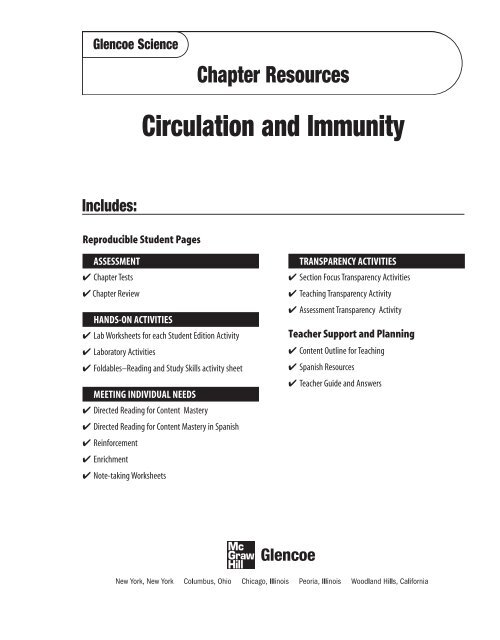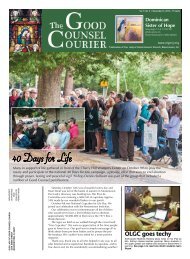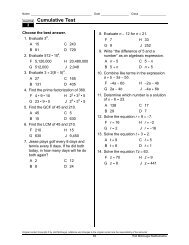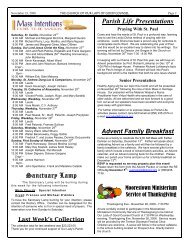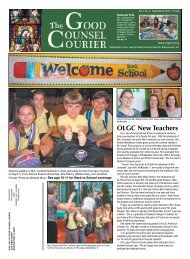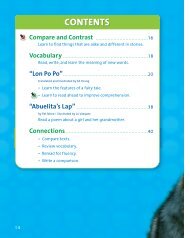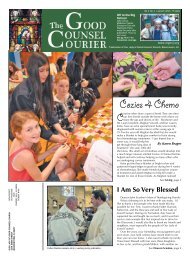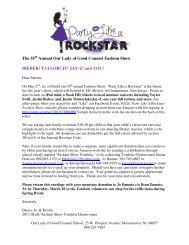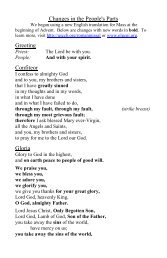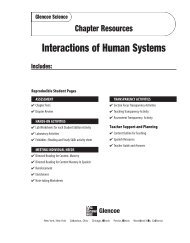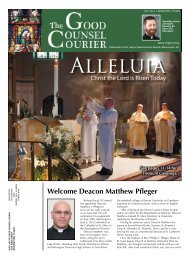Chapter 13 Resource: Circulation and Immunity
Chapter 13 Resource: Circulation and Immunity
Chapter 13 Resource: Circulation and Immunity
Create successful ePaper yourself
Turn your PDF publications into a flip-book with our unique Google optimized e-Paper software.
Glencoe Science<strong>Chapter</strong> <strong>Resource</strong>s<strong>Circulation</strong> <strong>and</strong> <strong>Immunity</strong>Includes:Reproducible Student PagesASSESSMENT✔ <strong>Chapter</strong> Tests✔ <strong>Chapter</strong> ReviewHANDS-ON ACTIVITIES✔ Lab Worksheets for each Student Edition Activity✔ Laboratory Activities✔ Foldables–Reading <strong>and</strong> Study Skills activity sheetMEETING INDIVIDUAL NEEDS✔ Directed Reading for Content Mastery✔ Directed Reading for Content Mastery in Spanish✔ Reinforcement✔ Enrichment✔ Note-taking WorksheetsTRANSPARENCY ACTIVITIES✔ Section Focus Transparency Activities✔ Teaching Transparency Activity✔ Assessment Transparency ActivityTeacher Support <strong>and</strong> Planning✔ Content Outline for Teaching✔ Spanish <strong>Resource</strong>s✔ Teacher Guide <strong>and</strong> Answers
Glencoe SciencePhoto CreditsSection Focus Transparency 1: Gail Meese/Meese Photo ResearchSection Focus Transparency 2: Gordon R. Gainer/The Stock MarketSection Focus Transparency 3: Juergen Berger,Max-Planck Institute/Science Photo Library/PhotoResearchersSection Focus Transparency 4: S. Lowry/Univ. Ulster/StoneCopyright © by The McGraw-Hill Companies, Inc. All rights reserved.Permission is granted to reproduce the material contained herein on the conditionthat such material be reproduced only for classroom use; be provided to students,teachers, <strong>and</strong> families without charge; <strong>and</strong> be used solely in conjunction with the<strong>Circulation</strong> <strong>and</strong> <strong>Immunity</strong> program. Any other reproduction, for use or sale, isprohibited without prior written permission of the publisher.Send all inquiries to:Glencoe/McGraw-Hill8787 Orion PlaceColumbus, OH 43240-4027ISBN 0-07-867833-1Printed in the United States of America.1 2 3 4 5 6 7 8 9 10 024 09 08 07 06 05 04
ReproducibleStudent PagesReproducible Student Pages■ H<strong>and</strong>s-On ActivitiesMiniLAB: Modeling Scab Formation . . . . . . . . . . . . . . . . . . . . . . . . . . 3MiniLAB: Try at Home Determining Reproduction Rates . . . . . . . . . . 4Lab: Microorganisms <strong>and</strong> Disease . . . . . . . . . . . . . . . . . . . . . . . . . . . . . 5Lab: Design Your Own Blood Type Reactions. . . . . . . . . . . . . . . . . . . . 7Laboratory Activity 1: Heart Structure. . . . . . . . . . . . . . . . . . . . . . . . . 9Laboratory Activity 2: Blood Pressure . . . . . . . . . . . . . . . . . . . . . . . . <strong>13</strong>Foldables: Reading <strong>and</strong> Study Skills. . . . . . . . . . . . . . . . . . . . . . . . . . 17■ Meeting Individual NeedsExtension <strong>and</strong> InterventionDirected Reading for Content Mastery . . . . . . . . . . . . . . . . . . . . . . . 19Directed Reading for Content Mastery in Spanish . . . . . . . . . . . . . . 23Reinforcement . . . . . . . . . . . . . . . . . . . . . . . . . . . . . . . . . . . . . . . . . . 27Enrichment. . . . . . . . . . . . . . . . . . . . . . . . . . . . . . . . . . . . . . . . . . . . . 31Note-taking Worksheet . . . . . . . . . . . . . . . . . . . . . . . . . . . . . . . . . . . 35■ Assessment<strong>Chapter</strong> Review . . . . . . . . . . . . . . . . . . . . . . . . . . . . . . . . . . . . . . . . . 41<strong>Chapter</strong> Test . . . . . . . . . . . . . . . . . . . . . . . . . . . . . . . . . . . . . . . . . . . . 43■ Transparency ActivitiesSection Focus Transparency Activities . . . . . . . . . . . . . . . . . . . . . . . . 48Teaching Transparency Activity . . . . . . . . . . . . . . . . . . . . . . . . . . . . . 53Assessment Transparency Activity . . . . . . . . . . . . . . . . . . . . . . . . . . . 55<strong>Circulation</strong> <strong>and</strong> <strong>Immunity</strong> 1
H<strong>and</strong>s-On ActivitiesH<strong>and</strong>s-OnActivities2 <strong>Circulation</strong> <strong>and</strong> <strong>Immunity</strong>
Name Date ClassMicroorganisms <strong>and</strong> DiseaseLab PreviewDirections: Answer these questions before you begin the Lab.1. Which safety symbols are associated with this lab?H<strong>and</strong>s-On Activities2. What is the source of microorganisms in this lab?Microorganisms are everywhere. Washing your h<strong>and</strong>s <strong>and</strong> disinfecting itemsyou use helps remove some of these organisms.Copyright © Glencoe/McGraw-Hill, a division of the McGraw-Hill Companies, Inc.Real-World QuestionHow do microorganisms cause infection?Materialsfresh apples (6) self-sealing plastic bags (6) paper towels soap <strong>and</strong> waterrotting apple labels <strong>and</strong> pencil s<strong>and</strong>paper newspaperrubbing alcohol (5 mL) gloves cotton ballGoals■ Observe the transmission of microorganisms.■ Relate microorganisms to infections.Safety PrecautionsWARNING: Do not eat the apples. Do not remove goggles until the lab <strong>and</strong> cleanup arecompleted. When you complete the experiment, give all bags to your teacher for disposal.Procedure1. Label the plastic bags 1 through 6.Put ongloves. Place a fresh apple in bag 1.2. Rub the rotting apple over the other fiveapples. This is your source of microorganisms.WARNING: Don’t touch yourface.3. Put one apple in bag 2.4. Hold one apple 1.5 m above the floor <strong>and</strong>drop it on a newspaper. Put it in bag 3.5. Rub one apple with s<strong>and</strong>paper. Place thisapple in bag 4.6. Wash one apple with soap <strong>and</strong> water. Dry itwell. Put this apple in bag 5.7. Use a cotton ball to spread alcohol over thelast apple. Let it air-dry. Place it in bag 6.8. Seal all bags <strong>and</strong> put them in a dark place.9. On day 3 <strong>and</strong> day 7, compare all of theapples without removing them from thebags. Record your observations in Table 1.<strong>Circulation</strong> <strong>and</strong> <strong>Immunity</strong> 5
Name Date Class(continued)H<strong>and</strong>s-On ActivitiesData <strong>and</strong> ObservationsTable 1ApplesApple ObservationsNumberCondition Day 3 Day 71 Fresh2Untreated3Dropped4Rubbed with s<strong>and</strong>paper5Washed with soap <strong>and</strong> water6Covered with alcoholConclude <strong>and</strong> Apply1. Infer How does this experiment relate to infections on your skin?2. Explain why it is important to clean a wound.Communicating Your DataPrepare a poster illustrating the advantages of washing h<strong>and</strong>s to avoid the spread ofdisease. Get permission to put the poster near a school rest room. For more help, refer tothe Science Skill H<strong>and</strong>book.Copyright © Glencoe/McGraw-Hill, a division of the McGraw-Hill Companies, Inc.6 <strong>Circulation</strong> <strong>and</strong> <strong>Immunity</strong>
Name Date ClassDesign Your OwnBlood Type ReactionsLab PreviewDirections: Answer these questions before you begin the Lab.1. Which simulated blood type will be used as the control?H<strong>and</strong>s-On Activities2. Why is it important to NOT eat, taste, or drink laboratory materials?Human blood can be classified into four main blood types—A, B, AB, <strong>and</strong> O.These types are determined by the presence or absence of antigens on the redblood cells. After blood is collected into a transfusion bag, it is tested todetermine the blood type. The type is labeled clearly on the bag. Blood isrefrigerated to keep it fresh <strong>and</strong> available for transfusion.Copyright © Glencoe/McGraw-Hill, a division of the McGraw-Hill Companies, Inc.Real-World QuestionWhat happens when two different blood typesare mixed?Form a HypothesisBased on your reading <strong>and</strong> observations, forma hypothesis to explain how different bloodtypes will react to each other.Safety PrecautionsWARNING: Do not taste, eat or drink anymaterials used in the lab.Possible Materialssimulated blood (10 mL low-fat milk <strong>and</strong>10 mL water plus red food coloring)lemon juice as antigen A (for blood types B<strong>and</strong> O)water as antigen A (for blood types A <strong>and</strong> AB)dropperssmall paper cupsmarking pen10-mL graduated cylinderGoals■ Design an experiment that simulates thereactions between different blood types.■ Identify which blood types can donate towhich other blood types.Test Your HypothesisMake a Plan1. As a group, agree upon a hypothesis <strong>and</strong>decide how you will test it. Identify theresults that will confirm the hypothesis.2. List the steps you must take <strong>and</strong> the materialsyou will need to test your hypothesis. Bespecific. Describe exactly what you will do ineach step.3. Prepare a data table like the one in yourtext on a separate sheet of paper to recordyour observations.4. Reread the entire experiment to make sureall steps are in logical order.5. Identify constants <strong>and</strong> variables.Blood type O will be the control.Follow Your Plan1. Make sure your teacher approves your planbefore you start.2. Carry out the experiment according to theapproved plan.3. While doing the experiment, record yourobservations <strong>and</strong> complete the data table.<strong>Circulation</strong> <strong>and</strong> <strong>Immunity</strong> 7
Name Date ClassCopyright © Glencoe/McGraw-Hill, a division of the McGraw-Hill Companies, Inc.1LaboratoryActivityHeart StructureCan you name the part of your body that is a muscle, works on its own without any reminderfrom you, pushes about five liters of liquid through your body each minute, relaxes for only abouthalf a second, <strong>and</strong> squeezes or contracts 70 to 100 times a minute? The organ described is thehuman heart.StrategyYou will observe the outside <strong>and</strong> inside of a cow or sheep heart to locate <strong>and</strong> label the partsof a heart.You will study the direction of blood flow through the heart.You will review the condition of blood on the right side of the heart as compared with theblood on the left side.Materials2 colored pencils (red <strong>and</strong> blue)dissecting p<strong>and</strong>issecting probeheart (sheep or cow)*narrow tongue depressors*coffee stirrers (alternative)ProcedurePart A—Outside of Heart1. Position your sheep or cow heart in a dissectingpan so that it matches Figure 1.WARNING: Wash h<strong>and</strong>s thoroughly afterh<strong>and</strong>ling heart.NOTE: Use the description below <strong>and</strong> thedirections of arrows in Figure 2 to helplocate each part of the heart. Use Figure 2to label each part as you identify it.2. The superior <strong>and</strong> inferior vena cava returnblood to the right side of the heart frombody organs. Locate <strong>and</strong> label the superior<strong>and</strong> inferior vena cava. The pulmonaryvein returns blood to the left side of theheart from the lungs. Locate <strong>and</strong> label thepulmonary vein.3. Blood in veins enters the right <strong>and</strong> left atriums,two small chambers at the top of theheart. Locate <strong>and</strong> label the right atrium <strong>and</strong>left atrium.4. Pumping action of the heart squeezesblood from the atriums into the right <strong>and</strong>left ventricles, two large chambers at thebottom of the heart. Locate <strong>and</strong> label theright ventricle <strong>and</strong> left ventricle.Figure 15. Pumping action of the heart squeezesblood from the two ventricles. Blood leavesthe heart on the left side by way of anartery called the aorta. Locate <strong>and</strong> label theaorta, which carries blood to all body parts.Blood leaves the heart on the right side byway of another artery, the pulmonaryartery. Locate <strong>and</strong> label the pulmonaryartery, which carries blood to the lungs.<strong>Circulation</strong> <strong>and</strong> <strong>Immunity</strong> 9H<strong>and</strong>s-On Activities
Name Date ClassLaboratory Activity 1 (continued)H<strong>and</strong>s-On ActivitiesFigure 21.Blood to heartBlood from heart6.Blood to heart2.7.3.4.8.9.5.Part B—Inside of Heart1. Your teacher will slice open the heart witha scalpel.2. Note the thickness of the muscle thatmakes up the left <strong>and</strong> right ventricles.3. Locate <strong>and</strong> label the heart valves betweenatria <strong>and</strong> ventricles. Valves keep bloodflowing in one direction.4. Locate <strong>and</strong> label the valves where thepulmonary artery <strong>and</strong> aorta are joined tothe heart.10.Part C—Condition of Blood in Heart1. Use a blue pencil to color in the spaces onFigure 2 to show where deoxygenated bloodwould be. Blood returning to orpumped from the right side of the heart isdeoxygenated. This means that the amountof oxygen in the blood is low.2. Use a red pencil to color in spaces to showwhere oxygenated blood would be.Oxygenated blood contains a large amountof oxygen. Those vessels returning to orleaving the left side of the heart carryoxygenated blood.Copyright © Glencoe/McGraw-Hill, a division of the McGraw-Hill Companies, Inc.10 <strong>Circulation</strong> <strong>and</strong> <strong>Immunity</strong>
Name Date ClassLaboratory Activity 1 (continued)Data <strong>and</strong> Observations1. Label <strong>and</strong> color Figure 2 as instructed in the Procedure. NOTE: Notice that Figure 2 shows theleft <strong>and</strong> right sides of the heart reversed. The diagram actually shows the position of the heartin a person as it would appear if you were facing that person whose heart is shown.2. Complete Table 1. Use the words oxygenated or deoxygenated to describe the condition of theblood in each part. (See Part C of the Procedure.)Table 1H<strong>and</strong>s-On ActivitiesPartAtriumVentricleVena cavaAortaPulmonary veinPulmonary arteryRight sideLeft sideQuestions <strong>and</strong> Conclusions1. To what part of the body is blood pumped as it passes through the pulmonary artery?Copyright © Glencoe/McGraw-Hill, a division of the McGraw-Hill Companies, Inc.2. From what part of the body is blood being returned to the heart as it passes through thepulmonary veins? Through the vena cava?3. If blood leaves the right side of the heart deoxygenated <strong>and</strong> returns to the left side oxygenated,what gas has been added to the blood? Through what organ must the blood pass in order tochange in this way?4. Explain why the muscle of the left ventricle is thicker than the muscle of the right ventricle.5. Explain the function of the heart valves.<strong>Circulation</strong> <strong>and</strong> <strong>Immunity</strong> 11
Name Date ClassLaboratory Activity 1 (continued)H<strong>and</strong>s-On Activities6. List in order those parts that determine the direction of blood flow through the heart. Startwith the vena cava <strong>and</strong> include the following: left atrium, right atrium, left ventricle, rightventricle, pulmonary artery, pulmonary vein, aorta.7. Use the data in the Data <strong>and</strong> Observations section to explain the condition of all blood ina. the heart’s right side.b. the heart's left side.Strategy CheckCan you locate <strong>and</strong> properly label the following parts of the heart: vena cava, right atrium,left atrium, pulmonary artery, pulmonary vein, left ventricle, right ventricle, aorta?Can you rearrange the above parts in proper order starting with the vena cava to showthe direction of blood flow through the heart?Can you compare the condition of the blood on the right side of the heart to the bloodon the left side?Copyright © Glencoe/McGraw-Hill, a division of the McGraw-Hill Companies, Inc.12 <strong>Circulation</strong> <strong>and</strong> <strong>Immunity</strong>
Name Date ClassCopyright © Glencoe/McGraw-Hill, a division of the McGraw-Hill Companies, Inc.2LaboratoryActivityBlood PressureThe main blood vessels of the body are the arteries <strong>and</strong> the veins. The heart pumps blood to allparts of the body by way of arteries. Veins carry blood back to the heart. Blood within your bloodvessels is under pressure. Do arteries <strong>and</strong> veins have the same blood pressure?StrategyYou will build an artificial heart <strong>and</strong> blood vessels with a plastic squeeze bottle <strong>and</strong> glass <strong>and</strong>rubber tubing.You will measure <strong>and</strong> record the distance that water squirts from the glass tube <strong>and</strong> rubber tube.You will compare the distance water squirts from each tube to the softness of the tubes.Materialsfood coloring (red)2 glass tubes, 20 cm long <strong>and</strong> 5 cm long,5-mm inside diameter, inserted in a rubberstopper (2-hole) by your teachermeterstickrubber tube, 18 cm long, 5-mm inside diametersqueeze bottlewash panProcedure1. Fill a squeeze bottle with water. Add severaldrops of red food coloring to the water <strong>and</strong>shake gently.2. Put the rubber stopper, with tubesattached, into the squeeze bottle opening.The stopper should fit tightly.3. Rest a meterstick lengthwise on the edges of awashpan. Hold the rubber tube on one edgeof the washpan. The rubber tube should belevel with the glass tube. See Figure 2.Figure 2Figure 1Squeeze bottleRubber stopperGlass tube 20 cm longRubber tube 18 cm longShort length of glass tube4. While a classmate squeezes the bottle,determine how far the water stream fromeach tube travels. Record your resultin Table 1.5. Refill the bottle before each new trial <strong>and</strong>repeat steps 3 <strong>and</strong> 4 three more times.Again record the results in the table.H<strong>and</strong>s-On Activities<strong>Circulation</strong> <strong>and</strong> <strong>Immunity</strong> <strong>13</strong>
Name Date ClassLaboratory Activity 2 (continued)H<strong>and</strong>s-On ActivitiesData <strong>and</strong> Observations1. Record your results in Table 1. Use centimeter units.Table 1Trial1. Glass tube1 2 3 4 Average2. Rubber tube2. Calculate the average distance water travels for each tube. Record the average in the table.Questions <strong>and</strong> Conclusions1. The higher the pressure in a tube, the farther water will travel when it comes out of the tube. Inwhich tube was water pressure higher? In which tube was water pressure lower?2. Veins are soft <strong>and</strong> flexible, while arteries are tougher <strong>and</strong> less flexible. Which tube correspondsto an artery? Which tube corresponds to a vein?3. Using your results, compare blood pressure in arteries to blood pressure in veins.4. What part of your body can be compared to the squeeze bottle? The water?Copyright © Glencoe/McGraw-Hill, a division of the McGraw-Hill Companies, Inc.14 <strong>Circulation</strong> <strong>and</strong> <strong>Immunity</strong>
Name Date ClassLaboratory Activity 2 (continued)Blood pressure is described by measuring two events: (a) Systolic pressure—pressure when theventricles of the heart contract <strong>and</strong> push blood into arteries (b) Diastolic pressure—pressurewhen the ventricles relax <strong>and</strong> blood in the arteries is not being pushed.Blood pressure is a comparison of systolic to diastolic numbers. Figure 3 shows blood pressuremeasured in mm of mercury compared with age in years. For example, the systolic pressure for a10-year-old child is 100 mm of mercury. The diastolic pressure for this child is 65 mm of mercury.Blood pressure (mm of mercury)20018016014012010080604020Figure 300 5 10 15 20 25 30 35 40 45 50 55 60Age (years)Systolic pressureDiastolic pressureH<strong>and</strong>s-On Activities5. a. What is the systolic pressure for a 20-year-old person?b. What is the diastolic pressure for a 20-year-old person?Copyright © Glencoe/McGraw-Hill, a division of the McGraw-Hill Companies, Inc.6. From the graph, determine the blood pressure for the following ages: (list systolic, thendiastolic.)a. 15 years old ______________________________________________________________b. 30 years old ______________________________________________________________c. 40 years old ______________________________________________________________7. a. How much change occurs in systolic pressure from age 0 to 60?b. How much change occurs in diastolic pressure from age 0 to 60?<strong>Circulation</strong> <strong>and</strong> <strong>Immunity</strong> 15
Name Date ClassLaboratory Activity 2 (continued)H<strong>and</strong>s-On Activities8. a. Does systolic blood pressure change more from age 0 to 20 than from age 20 to 60?9. a. At what age is there the greatest difference between systolic pressure <strong>and</strong> diastolic pressure?b. What is the blood pressure at this age? _________________________________________10. The age of a person with a systolic pressure of 120 <strong>and</strong> diastolic pressure of 75 should beclose to what?A person is said to have high blood pressure if systolic <strong>and</strong> diastolic pressures are higher than normal.A person is said to have a low blood pressure if systolic <strong>and</strong> diastolic pressure are lower thannormal. Record if the following people have high, low, or normal blood pressure by comparing thepressure in Table 2 with those in the graph in Figure 3.Table 2AgeBlood PressureSystolic Diastolic Pressure45 140 83 11.Strategy Check30 <strong>13</strong>0 8560 140 80Did you build an artificial heart <strong>and</strong> blood vessels?Did you determine which tube, glass or rubber, allows the water to squirt out fartherwhen the bottle is squeezed?Can you correlate the distance water squirts to the softness of the rubber <strong>and</strong> glass tubes?12.<strong>13</strong>.Copyright © Glencoe/McGraw-Hill, a division of the McGraw-Hill Companies, Inc.16 <strong>Circulation</strong> <strong>and</strong> <strong>Immunity</strong>
Name Date Class<strong>Circulation</strong>Directions: Use this page to label your Foldable at the beginning of the chapter.<strong>Circulation</strong>H<strong>and</strong>s-On ActivitiesPulmonaryCoronarySystemicthe flow of blood to <strong>and</strong>from the tissues of the heartCopyright © Glencoe/McGraw-Hill, a division of the McGraw-Hill Companies, Inc.the flow of blood throughthe heart to the lungs <strong>and</strong>back to the heartthe flow of blood to all ofthe organs <strong>and</strong> body tissues,except the heart <strong>and</strong> lungs<strong>Circulation</strong> <strong>and</strong> <strong>Immunity</strong> 17
Meeting Individual NeedsMeeting IndividualNeeds18 <strong>Circulation</strong> <strong>and</strong> <strong>Immunity</strong>
Name Date ClassDirected Reading forContent MasteryOverview<strong>Circulation</strong> <strong>and</strong> <strong>Immunity</strong>Directions: Use the following terms to complete the concept map belowheart arteries lungscapillariesvena cava4.which carryoxygen-poorblood into thewhich leadsto thewhich returnoxygenatedblood to thepulmonary veinsto the1.5.whichpumps bloodthrough thewhich pumpsblood through thepulmonary arteryto theaorta<strong>and</strong> otherMeeting Individual NeedsCopyright © Glencoe/McGraw-Hill, a division of the McGraw-Hill Companies, Inc.veinswhich connect toDirections: Complete the following sentences using the correct terms.6. Once tissue fluid diffuses into the lymphatic capillaries, it is called____________________.3.<strong>and</strong> then to7. ____________________ are lymphatic organs that protect your mouth <strong>and</strong> noseform harmful microorganisms.2.<strong>Circulation</strong> <strong>and</strong> <strong>Immunity</strong> 19
Meeting Individual NeedsName Date ClassDirections: Use the following terms to correctly complete the sentences below.arteries chambers white veins fibrin lymph nodes1. The heart has four cavities called ____________________.2. ____________________ move blood away from the heart, while____________________ move blood to the heart.3. ____________________ blood cells fight bacteria <strong>and</strong> viruses.4. When you get a minor cut, platelets in your blood stick to the wound <strong>and</strong> cause____________________ threads to form a clot.5. ____________________ filter out microorganisms <strong>and</strong> foreign material thathave been engulfed by the lymphocytes.Directions: The parts of the human blood are shown below. Write the function of each part on the lines belowthe illustration. Use the following terms.6. a.b.c.d.Directed Reading forContent MasteryA. White blood cellsSection 1 ■Section 2 ■help clot bloodcontains nutrients <strong>and</strong> mineralsBlood<strong>Circulation</strong>contain hemoglobinhelp fight infectionB. Red blood cells C. Platelets D. PlasmaCopyright © Glencoe/McGraw-Hill, a division of the McGraw-Hill Companies, Inc.20 <strong>Circulation</strong> <strong>and</strong> <strong>Immunity</strong>
Name Date ClassDirected Reading forContent MasteryKey Terms<strong>Circulation</strong> <strong>and</strong> <strong>Immunity</strong>Directions: Draw a line to connect the description on the left to the correct term on the right.Meeting Individual Needs1. microscopic blood vessel that connectsarteries <strong>and</strong> veins2. vessel that carries blood away fromthe heart3. chemical that carries oxygen <strong>and</strong> carbondioxide in the blood4. upper chamber of the heart5. liquid part of the blood that carriesnutrients <strong>and</strong> minerals6. organ that filters out microorganisms<strong>and</strong> foreign materialsarteryallergencapillaryhemoglobinlymph nodelymphocyte7. white blood cell carried in thelymphatic system8. lower chamber of the heart9. flow of blood from the heart to otherorgans <strong>and</strong> tissues of the body exceptthe heart <strong>and</strong> lungs10. flow of blood from the heart to thelungs <strong>and</strong> back to the heart11. system that defends the body againstdiseaseimmunepulmonary circulationsystemic circulationventricleplasmaCopyright © Glencoe/McGraw-Hill, a division of the McGraw-Hill Companies, Inc.12. substance that causes an allergicresponse22 <strong>Circulation</strong> <strong>and</strong> <strong>Immunity</strong>atruim
Name Date ClassLectura dirigida paraDominio del contenidoSinopsisCirculación y sistema inmuneInstrucciones: Completa el mapa de conceptos us<strong>and</strong>o los términos de la siguiente lista.corazón arterias pulmonescapilaresvena cava1.y saca la sangreescasa en oxígenoa través de las4.que conduce(n)al o a lael(la) cual devuelvesangre oxigenada a lasvenas pulmonaresde(l)5.bombea sangre através de labombea sangre através de laarteria pulmonarde(l)aortay otros(as)Satisface las necesidades individualesCopyright © Glencoe/McGraw-Hill, a division of the McGraw-Hill Companies, Inc.venasconectadas al (a los)Instrucciones: Completa las siguientes oraciones us<strong>and</strong>o el término correcto.6. Una vez que el fluido tisular se difunde en los capilares linfáticos, ésta se conocecomo _____________.3.y luego al (a los)7. Los(Las)____________________ son órganos linfáticos que te protegen la narizy la boca de los microorganismos dañinos.2.Circulación y sistema inmune 23
Name Date ClassLectura dirigida paraDominio del contenidioSección 1 ■ La sangreSección 2 ■ El sistema circulatorioarterias cavidades blancos venas fibrina nódulos linfáticosSatisface las necesidades individuales1. El corazón posee cuatro cavidades llamadas ____________________.2. Los(Las) ____________________ sacan la sangre del corazón, mientras quelos(las) ____________________ llevan la sangre al corazón.3. Los glóbulos ____________________ combaten las bacterias y los virus.4. Cu<strong>and</strong>o sufres una herida leve, las plaquetas en la sangre se adhieren a la herida yhacen que se formen hebras de ____________________ para formar un coágulo.5. Los(Las) ____________________ filtran los microorganismos y el material foráneoque engullen los linfocitos.Instrucciones: A continuación se muestran las partes de la sangre humana. Escribe la función de cada parte enlas líneas en blanco debajo de cada ilustración. Usa los siguientes términos.ayudan a coagular la sangrecontiene nutrientes y mineralescontienen hemoglobinaayudan a combatir infecciones6. a.A. Glóbulos blancos B. Glóbulos rojos C. PlaquetasD. Plasmab.c.d.Copyright © Glencoe/McGraw-Hill, a division of the McGraw-Hill Companies, Inc.24 Circulación y sistema inmune
Nombre Fecha ClaseLectura dirigida paraDominio del contenidioSección 3 ■ El sistema inmunológicoSección 4 ■ EnfermedadesInstrucciones: Estudia el diagrama. Llena la tabla con la descripción de lo que está sucediendo en cada fase.A.Glóbulo blancoCélula T ayudante B.AnticuerpoCopyright © Glencoe/McGraw-Hill, a division of the McGraw-Hill Companies, Inc.EtapaABCDD.Reconocimiento:Mobilización:Eliminación:Inmunidad:PatógenoCélula B de memoriaInstrucciones: Encierra en un círculo el término en paréntesis que completa correctamente cada oración.1. El uso de sustancias químicas para destruir células cancerosas es(inmunología/quimioterapia).2. Las enfermedades (no infecciosas/infecciosas) NO son causadas por bacterias ovirus.C.DescripciónCélula BSatisface las necesidades individualesCirculación y sistema inmune 25
Nombre Fecha ClaseLectura dirigida paraDominio del contenidioTérminos clavesCirculación y sistema inmuneInstrucciones: Conecta la descripción con el término correcto.1. vaso sanguíneo microscópico queconecta las arterias y las venasarteria2. vaso que saca la sangre del corazónalergénicoSatisface las necesidades individuales3. sustancia química que transporta oxígenoy dióxido de carbono en la sangre4. cavidad superior del corazón5. parte líquida de la sangre que llevanutrientes y minerales6. órgano que filtra los microorganismos ylos materiales foráneos7. glóbulo blanco que se encuentra en elsistema linfático8. cavidad inferior del corazón9. flujo de sangre desde el corazón a otrosórganos y tejidos del cuerpo, excepto elcorazón y los pulmones10. flujo de sangre desde el corazón a lospulmones y de regreso al corazón11. sistema que defiende al cuerpo de lasenfermedadescapilarhemoglobinaganglio linfáticolinfocitoinmunecirculación pulmonarcirculación sistémicaventrículoplasmaCopyright © Glencoe/McGraw-Hill, a division of the McGraw-Hill Companies, Inc.12. sustancia que causa una respuestaalérgicaaurícula26 Circulación y sistema inmune
Nombre Fecha Clase1ReinforcementBloodDirections: Fill in the missing words in the following statements to describe the four functions of blood.1. carries _____________________ to all body cells <strong>and</strong> removes _____________________2. carries _____________________ of cell activity to _____________________ to be removed3. transports _____________________ from the digestive system to all cells4. carries materials that fight _____________________ <strong>and</strong> heal woundsDirections: The parts of human blood are shown below. Use the following phrases to write what each part doeson the line below its picture: help clot blood; transport oxygen; contains nutrients <strong>and</strong> minerals; helpfight infection.A. White blood cellsB. Red blood cells C. Platelets D. PlasmaMeeting Individual NeedsCopyright © Glencoe/McGraw-Hill, a division of the McGraw-Hill Companies, Inc.5. a.b.Directions: Complete the following table. Possible blood types of the donor are listed horizontally. The possibleblood types of the receiver are listed vertically. Make a check in the box if the receiver can receive blood from thedonor directly above. Then answer the questions below the table.Receiver(can receiveblood from)Blood type6. O7. A8. B9. ABc.d.Donor (can give blood to)O A B AB10. Who can receive any blood type? ________________________________________________11. Who can receive only O type blood? _____________________________________________<strong>Circulation</strong> <strong>and</strong> <strong>Immunity</strong> 27
Nombre Fecha Clase2Reinforcement<strong>Circulation</strong>Directions: Fill in the blanks with the correct terms for questions 1–3.1. Valves inside the veins prevent blood from flowing ____________________ the heart.2. Blood in ____________________ carries wastes away from the cells of the body back to the heart.3. The force of the blood on the walls of blood vessels is called ____________________.4. What are three main functions of the lymphatic system?Meeting Individual Needs5. What is pulmonary circulation <strong>and</strong> what is its function?_______________________________Directions Label the diagram of the heart. Include the following terms on your diagram: right atrium, rightventricle, left atrium, left ventricle, superior vena cava, inferior vena cava, pulmonary artery,pulmonary vein, aorta. Use a pencil to draw arrows showing the path of oxygen-rich blood. Use a pen toshow the path of oxygen-poor blood.6.7.8.9.10.11.To lungsFrom lungs12.<strong>13</strong>.14.To smaller arteries <strong>and</strong> capillariesCopyright © Glencoe/McGraw-Hill, a division of the McGraw-Hill Companies, Inc.28 <strong>Circulation</strong> <strong>and</strong> <strong>Immunity</strong>
Name Date Class3Reinforcement<strong>Immunity</strong>Directions: Answer the following questions on the lines provided.1. What is an antibody <strong>and</strong> how does it function?2. What is one source of passive immunity?3. What is the difference between active immunity <strong>and</strong> passive immunity?4. What happens if disease-causing bacteria get through a break in the skin <strong>and</strong> enter thecirculatory system?5. What are vaccines made from?Meeting Individual Needs6. How are pathogens trapped by <strong>and</strong> expelled from the respiratory system?Copyright © Glencoe/McGraw-Hill, a division of the McGraw-Hill Companies, Inc.7. What are your body’s first-line defenses against pathogens in general?8. a. How do vaccines work?b. What is this type of immunity called?c. What is another way to get this type of immunity?9. What defenses does the digestive system have against pathogens?10. What is an antigen?<strong>Circulation</strong> <strong>and</strong> <strong>Immunity</strong> 29
Name Date Class4ReinforcementDiseasesDirections: Robert Koch developed a set of rules for figuring out which pathogen caused a particular disease.Use the following terms to complete his rules listed below.disease original organism present hostsuspected culture same1. In every case of a particular disease, the organism thought to cause the _____________________Meeting Individual Needsmust be _____________________.2. The _____________________ pathogen must be separated from all other organisms <strong>and</strong>grown in a _____________________ with no other organisms present.3. When the suspected pathogen from the pure culture is placed in a healthy_____________________, it must cause the same disease.4. When the suspected pathogen is removed from the host <strong>and</strong> grown again, it must be comparedwith the _____________________ to see if they are the _____________________.Directions: Write the letter of the term or phrase that best completes the sentence.30 <strong>Circulation</strong> <strong>and</strong> <strong>Immunity</strong>5. Diseases that are not caused by pathogens are _____.a. infectious b. chronic c. noninfectious d. viral6. A tumor is usually located _____.a. anywhere in the body c. near the surface of the bodyb. deep inside the body d. on the skin7. All of the following are noninfectious diseases EXCEPT _____.a. asthma b. cancer c. heart disease d. AIDS8. Substances that increase your chance of developing cancer are called _____.a. lymphocytes b. carcinogens c. allergens d. antigens9. When you come in contact with an allergen, your immune system forms _____.a. hormones b. lymphocytes c. antibodies d. antigens10. An allergy is a strong reaction of the _____.a. immune system c. respiratory systemb. circulatory system d. digestive system11. Some noninfectious diseases are called chronic diseases because _____.a. they are present at birth c. they are short-livedb. they are inherited d. they last a long time12. Cigarette smoke has been linked with all of the following EXCEPT _____.a. cancer b. lung diseases c. heart disease d. arthritisCopyright © Glencoe/McGraw-Hill, a division of the McGraw-Hill Companies, Inc.
Name Date Class1EnrichmentSickle-Cell AnemiaCopyright © Glencoe/McGraw-Hill, a division of the McGraw-Hill Companies, Inc.1. What is the important function of red blood cells?2. What does a sickle-cell blood cell look like?3. Why is the shape of the sickle cell a problem?4. What can be a benefit of having a gene for sickle-cell anemia?One of the primary parts of blood is the redblood cell (RBC). It is a cell shaped like a flatcircle or inner tube. This cell contains animportant molecule called hemoglobin, whichis the molecule that carries oxygen to tissues<strong>and</strong> carbon dioxide away from them.There is a genetic disorder called sickle-cellanemia that changes the shape of the hemoglobinmolecule. This causes the shape of theRBC to change. Instead of having the flat circularshape of a regular RBC, the cell becomeslong <strong>and</strong> pointed. The sides of the cell mayturn up <strong>and</strong> the shape of the sickle cell looksvery much like a taco shell.A Painful EffectOne of the main problems with these cellsis that they do not flow easily through smallcapillaries. They tend to get clumped together<strong>and</strong> block parts of the circulatory system fromdelivering oxygen. This can be very painful tothe person with sickle-cell anemia. Many peoplecarry the sickle-cell gene, but in peoplewho have inherited the gene from only oneparent, the gene is rarely expressed. Only individualswho inherited the gene from both parentscommonly develop the symptoms. Thesepeople may die from sickle-cell anemia, butthe people who have only one copy of thegene do not.Malaria ResistanceHumans with either genetic combinationappear to be resistant to the deadly diseasemalaria. Malaria is caused by a small parasitecalled Plasmodium. It is carried by a certainspecies of mosquitoes <strong>and</strong> transferred tohumans by the bite of this small insect. Plasmodiumlives in the RBCs of infected humans whereit can cause nausea, vomiting, diarrhea, <strong>and</strong> maylead to death in many children <strong>and</strong> adults.Plasmodium cannot live long in sickledRBCs so infected people usually survive thisdisease. Sickle-cell anemia is found in peoplewho live in or have ancestors from tropicalclimates, such as parts of Africa, the Mediterranean,<strong>and</strong> the West Indies. Malaria is verycommon in these places. Sickle-cell anemiahelps them to survive malaria, one of thedeadliest diseases on Earth. Therefore, sicklecellanemia is a good example of a geneticadaptation.Meeting Individual Needs<strong>Circulation</strong> <strong>and</strong> <strong>Immunity</strong> 31
Name Date Class2EnrichmentExercise <strong>and</strong> <strong>Circulation</strong>Design an experiment to test the circulation of six of your friends or family members. Choosean exercise that will increase circulation, such as running in place or jumping jacks. Take a pulsereading or a blood pressure reading for each person before <strong>and</strong> after exercising. Make sure theexercise is not too strenuous for anyone you are testing.Meeting Individual NeedsDirections: Fill in the following table as you conduct your experiment. The rate in the table refers to the pulserate or blood pressure reading. If you need more space, use a separate sheet of paper.Table 1NameAge of personRate before exerciseType of exercisePerson 1 Person 2 Person 3 Person 4 Person 5 Person 6Length of timeexercisingRate after exercisingRate after restingDirections: Write a conclusion for your experiment. Include answers to the following questions.1. Did the heart rate differ with age?2. Did the heart rate go up by the same amount in all the people tested?3. How long did each person rest after exercising? Had his or her heart returned to the firstmeasurement? Test yourself to see how long it takes for your heart rate to return to normal.ConclusionCopyright © Glencoe/McGraw-Hill, a division of the McGraw-Hill Companies, Inc.32 <strong>Circulation</strong> <strong>and</strong> <strong>Immunity</strong>
Name Date Class3EnrichmentVaccines Through the CenturiesCopyright © Glencoe/McGraw-Hill, a division of the McGraw-Hill Companies, Inc.The first vaccine was developed in 1796when Edward Jenner observed that milkmaidswho contracted cowpox seemed unlikely tocontract deadly smallpox. He hypothesizedthat contracting cowpox prevented a personfrom getting smallpox. To test his hypothesis,Dr. Jenner took a few drops of cowpox fluidfrom a milkmaid with the disease <strong>and</strong>injected it into a boy who had neither cowpoxnor smallpox. Six weeks later, the doctorinjected the boy with a few drops of smallpoxfluid. The boy did not develop smallpox, <strong>and</strong>the first vaccine was born. In 1980, anupdated version of Dr. Jenner’s vaccine led tothe elimination of the smallpox virus.Vaccines TodaySince the development of the first vaccine,more than 20 vaccines have been created thatprotect us from such infectious <strong>and</strong> deadlydiseases as whooping cough, measles, mumps,rabies, tetanus, <strong>and</strong> polio.Creating vaccines has come a long way, too.Since scientists learned to use vaccines to “trick”the body’s immune system into producing antibodiesthat protect against a real disease-causingorganism, vaccines have been created usingweakened or killed microbes, as well asinactivated toxins. Now, however, scientists areable to develop new <strong>and</strong> improved vaccines.Subunit VaccineOne such vaccine is called the subunit vaccine.It works by creating an immune responsein the body without causing potentiallydangerous extra immune reactions like some1. Explain how vaccines work.traditional vaccines. Subunit vaccines aredeveloped from part of a bacterium or virus<strong>and</strong> are now available for hepatitis B <strong>and</strong>typhoid.Conjugate VaccinesAnother new kind of vaccine is a conjugatevaccine. Conjugate vaccines offer new hope forimmunizing babies against bacterial diseases likepneumonia <strong>and</strong> meningitis. Babies have differentimmune responses than adults, so until conjugatevaccines were developed, there was noway to immunize babies against these bacterialdiseases. Conjugate vaccines are really just combinedvaccines. They are developed by linkingproteins or inactivated toxins from one organismto the outer coat of the specific bacteria.Genome SequencingAdvances in biotechnology might allowscientists to develop DNA vaccines that couldpotentially offer lifelong protection againstmalaria, influenza, <strong>and</strong> HIV. Scientists also arelooking at using genome sequencing to developvaccines. Genome sequencing is a process bywhich scientists look at <strong>and</strong> try to underst<strong>and</strong>the genetic instructions of disease-causingmicrobes. Having more information about anorganism could help them develop vaccines fordiseases such as tuberculosis <strong>and</strong> syphilis.Finally, scientists are working to createedible vaccines. By genetically engineeringpotatoes, bananas, <strong>and</strong> tomatoes, scientistsbelieve they can safely trigger an immuneresponse to E. coli bacteria.2. What disease has been completely eliminated because of the use of vaccines?3. How can genomic sequencing help to develop vaccines?Meeting Individual Needs<strong>Circulation</strong> <strong>and</strong> <strong>Immunity</strong> 33
Name Date Class4EnrichmentAsthma: a Chronic DiseaseMeeting Individual NeedsMore than 17 million Americans haveasthma. About 5 million of that number arechildren. In children, asthma leads to moreschool absences <strong>and</strong> hospital stays, <strong>and</strong> restrictsmore activities than any other disease.It can be frightening to see a person havingan asthma attack. The person may be wheezing,coughing, breathing rapidly, or even gaspingfor air. It is important to underst<strong>and</strong> thatalthough this disease is chronic, it can becontrolled. Asthma is not contagious.Developing AsthmaAnyone can develop asthma. In children,the symptoms usually appear before age three.Some children seem to outgrow the disease,but often it reappears. In most cases, peoplelearn how to prevent asthma attacks <strong>and</strong> howto treat them when they do occur. Asthmapatients must learn what triggers their asthmaattacks so that they can prevent them.What happens during an attack?During an asthma attack, the musclesaround the bronchial tubes tighten <strong>and</strong> gointo a spasm. Extra mucus is produced <strong>and</strong>interferes with breathing. The lining of thebronchial tubes swells, making the airwaysmaller. The person has trouble passing air in<strong>and</strong> out <strong>and</strong> begins to wheeze or cough.Causes of AsthmaAsthma attacks can be caused by manythings. These causes are usually specific foreach person <strong>and</strong> are often a combination ofthings. The following list includes most of thebetter-known “triggers” for asthma.■ allergies—to grasses, trees, weeds, pollens,mold, dust, animal fur, food, <strong>and</strong> drugs■ respiratory infections—colds, sore throats■ irritants—perfume, smoke, air pollution■ physical exercise■ sudden change in air temperature or humidity■ emotional stressAsthma MedicationSeveral medications are available. Bronchodilatorsrelax the bronchial muscles inthe lungs. Cortisone reduces the swelling.Antibiotics fight infections. Allergy shots canreduce the sensitivity to allergens. Newermedications help reduce the allergic response.Also, a person can avoid things he or she isallergic to. This may mean getting rid of petsor avoiding certain foods. It is also wise to stayaway from cigarette smoke.1. Do you know anyone who has asthma? Find out how that person deals with his or her chronicdisease. Is he or she able to participate in most activities?2. Think about ways your school could make it easier for people with asthma to participate just likeeveryone else. Keep in mind that many schools do not let children carry inhalers (for medicine)with them. Why do you think this is a good or bad policy? In addition, many classrooms havefurry animals or birds. What options are there for children whose allergies to these animals couldtrigger an asthma attack?Copyright © Glencoe/McGraw-Hill, a division of the McGraw-Hill Companies, Inc.34 <strong>Circulation</strong> <strong>and</strong> <strong>Immunity</strong>
Name Date ClassNote-takingWorksheet<strong>Circulation</strong> <strong>and</strong> <strong>Immunity</strong>Section 1BloodA. Functions of blood1. Blood carries ___________ from your lungs to your body cells, <strong>and</strong> carbon dioxide fromyour cells to your lungs to be exhaled.2. Blood carries ___________ from cells to your kidneys to be removed.Copyright © Glencoe/McGraw-Hill, a division of the McGraw-Hill Companies, Inc.3. Blood transports ___________ to your body’s cells.4. Cells <strong>and</strong> molecules in blood fight ___________ <strong>and</strong> heal wounds.B. Parts of blood1. Plasma—___________ part of blooda. made mostly of ___________b. ___________, minerals, <strong>and</strong> oxygen are dissolved in plasma.2. ___________ supply your body with oxygen.a. Red blood cells contain ___________, which is a chemical that can carry oxygen <strong>and</strong>carbon dioxide.3. ___________ fight bacteria <strong>and</strong> viruses.a. Your body reacts to invaders by ___________ the number of white blood cells.b. White blood cells enter infected tissues, destroy bacteria <strong>and</strong> viruses, <strong>and</strong>absorb ___________4. ___________ are irregularly shaped cell fragments that help clot blood.C. Blood clotting—platelets <strong>and</strong> ___________ plug up a wound.1. ___________ stick to a wound <strong>and</strong> release chemicals.2. Threadlike fibers, called ___________, form a sticky net which helps make a ___________.3. ___________ then begin the repair process.D. Blood types—are chemical identification tags in the blood1. Types A, B, <strong>and</strong> AB—based on ___________2. Type _______ has no antigens, <strong>and</strong> can donate blood to any type.3. Type _______ has no antibodies, so it can receive blood from any type.4. ___________ is another chemical identification tag in blood.Meeting Individual Needs<strong>Circulation</strong> <strong>and</strong> <strong>Immunity</strong> 35
Name Date ClassNote-taking Worksheet (continued)E. Blood diseases1. Anemia affects ___________ blood cells.a. body tissues can’t get enough ___________ <strong>and</strong> are unable to carry on usual activitiesb. causes include a loss of large amounts of blood, diet lacking in _________, or heredity2. Leukemia—affects ___________a. Immature white blood cells are made in ___________ numbers.b. The excess cells don’t fight ___________ well; they fill the ___________ crowding outMeeting Individual Needsnormal cells.Section 2 <strong>Circulation</strong>A. Your ___________ system includes the blood, heart, <strong>and</strong> blood vessels.B. ___________—controls blood flow through all parts of the body1. Has four chambersa. ___________—upper two chambers; ___________—lower two chambersb. Blood ___________ only from an atrium to a ventricle.c. A ___________ between the two atriums or the two ventricles separates oxygen-richfrom oxygen-poor blood.2. Circulatory system—divided into ___________ sectionsa. ___________ circulation is the flow of blood to <strong>and</strong> from the tissues of the heart.b. In ___________ circulation, blood flows through the heart to the lungs, where carbondioxide <strong>and</strong> other waste materials diffuse out, oxygen diffuses in, <strong>and</strong> the blood goesback to the heart.c. ___________ circulation moves oxygen-rich blood to all the organs <strong>and</strong> body tissues,except the heart <strong>and</strong> lungs, <strong>and</strong> returns oxygen-poor blood to the heart.C. ___________ carry blood to every part of your body.1. ___________ are blood vessels that move blood away from the heart.2. ___________ carry blood back to the heart.3. ___________ are microscopic blood vessels that connect arteries to veins.Copyright © Glencoe/McGraw-Hill, a division of the McGraw-Hill Companies, Inc.36 <strong>Circulation</strong> <strong>and</strong> <strong>Immunity</strong>
Name Date ClassNote-taking Worksheet (continued)D. __________________________ is the force of the blood on the walls of the ___________.1. Blood pressure is highest in arteries <strong>and</strong> lowest in ___________. A rise <strong>and</strong> fall of pressureoccurs with each ___________.2. Your brain tries to keep your blood pressure _________. Your brain sends messages to yourheart to raise or lower your blood pressure by speeding up or slowing down your heart rate.E. ___________—the ___________ cause of death in the United StatesCopyright © Glencoe/McGraw-Hill, a division of the McGraw-Hill Companies, Inc.1. atherosclerosis—___________ build up on arterial walls <strong>and</strong> clog arteries2. hypertension—___________ blood pressure3. Prevention:a. Follow a healthful ___________, exercise, <strong>and</strong> have regular checkups.b. Avoid ___________; it increases carbon monoxide in the blood making the heart beatfaster.F. The lymphatic system collects ___________ <strong>and</strong> returns it to the blood.1. ___________–tissue fluid that contains ___________ <strong>and</strong> dissolved substancesa. contains ___________—type of white blood cell that helps the body defend itselfagainst disease causing organisms2. ___________ nodes—bean-shaped organs of varying size found ___________ the body;filter ___________ <strong>and</strong> foreign materials from lymphocytesSection 3 <strong>Immunity</strong>A. __________________________—complex set of defenses to protect the body from pathogens1. Unbroken ___________ is a barrier that prevents many pathogens from entering the body.2. The __________________________ traps pathogens with cilia <strong>and</strong> mucus.3. The ___________ uses saliva, enzymes, hydrochloric acid, <strong>and</strong> mucus to kill bacteria.4. The ___________ contains white blood cells that patrol the body <strong>and</strong> destroy pathogens.B. Specific immunity—the immune system works against a ___________ antigen by producing anantibody.1. In ___________ immunity the body makes its own antibodies in response to an antigen.___________ provides a form of an antigen to cause active immunity.Meeting Individual Needs<strong>Circulation</strong> <strong>and</strong> <strong>Immunity</strong> 37
Name Date ClassNote-taking Worksheet (continued)2. ___________ immunity—results when antibodies produced in another animal are introducedinto the body. Passive immunity does not ___________ as active immunity.Section 4DiseasesA. Scientists did not underst<strong>and</strong> how ___________ diseases were transmitted until the late 1800s<strong>and</strong> early 1900s.1. Louis Pasteur developed the ___________ process, which kills some bacteria in liquids.Meeting Individual Needs2. Robert Koch developed a method to ___________ <strong>and</strong> ___________ one type of bacteriumat a time.3. Joseph Lister learned to reduce surgery deaths by keeping his h<strong>and</strong>s <strong>and</strong> instruments___________.B. An ___________ disease is caused by a virus, bacterium, protist, or fungus <strong>and</strong> is spread froman infected organism or the environment to another organism.1. Diseases can be carried by ___________ such as rats, birds, cats, dogs, mosquitoes, fleas,<strong>and</strong> flies.2. ___________ can also be disease carriers.C. ___________ diseases (STDs) are infectious diseases spread during sexual contact.1. ___________ STDs include gonorrhea <strong>and</strong> syphilis.2. ___________ STDs include genital herpes <strong>and</strong> HIV (Human Immunodeficiency Virus).a. HIV infection can lead to ___________ (Acquired Immune Deficiency Syndrome)which attacks the immune system, causing the infected person to die of another disease.b. AIDS has no ___________, but several medicines are used to treat it.D. ___________ diseases are not spread from person to person; they may bechronic <strong>and</strong> long lasting.1. ___________ is a chronic disease associated with insulin production by the pancreas.a. ___________ diabetes results from too little or no production of insulin.b. ___________ diabetes results from improper insulin processing.2. ___________ results from uncontrolled cell growth <strong>and</strong> can occur anywhere in the body.a. Cancer can have many ___________ such as smoking, chemical exposure, radiationexposure, diet, or heredity.Copyright © Glencoe/McGraw-Hill, a division of the McGraw-Hill Companies, Inc.38 <strong>Circulation</strong> <strong>and</strong> <strong>Immunity</strong>
AssessmentAssessment40 <strong>Circulation</strong> <strong>and</strong> <strong>Immunity</strong>
Name Date Class<strong>Chapter</strong>Review<strong>Circulation</strong> <strong>and</strong> <strong>Immunity</strong>Part A. Vocabulary ReviewDirections: Complete the following sentences using the vocabulary words listed below.arteries capillaries hemoglobinlymph plasma platelets veins1. The blood vessels that move blood away from the heart are called ____________________.2. The blood vessels that move blood in the direction of the heart arecalled _____________________________3. _____________________________ are microscopic blood vessels that connect arteries <strong>and</strong> veins.4. _____________________________ is the liquid part of blood <strong>and</strong> is made mostly of water.5. Red blood cells contain _____________________________ , a chemical that can carry oxygen<strong>and</strong> carbon dioxide.6. _____________________________ are the odd-shaped cell fragments that help clot blood.7. Tissue fluid found inside lymphatic capillaries is known as _____________________________.Directions: Write the correct term in the space beside each definition.Copyright © Glencoe/McGraw-Hill, a division of the McGraw-Hill Companies, Inc.8. immunity that occurs when a body makes its own antibodies9. protein made in response to a specific antigen10. immunity that occurs when antibodies come from another source11. method of using heat to kill most bacteria in food12. diseases that are long-lasting <strong>and</strong> non-infectious<strong>13</strong>. substances foreign to the body14. substance that causes an allergic reaction15. diseases that cannot be spread16. diseases that are spread by water, air, food, contact, <strong>and</strong> vectorsAssessment<strong>Circulation</strong> <strong>and</strong> <strong>Immunity</strong> 41
Name Date Class<strong>Chapter</strong> Review (continued)Part B. Concept ReviewDirections: Answer the following questions on the lines provided.1. List three diseases caused by viruses.2. List three diseases caused by bacteria.3. Briefly describe how HIV affects the immune system.4. List five noninfectious diseases.AssessmentDirections: Answer the following questions using complete sentences.5. What is the significance of Koch’s rules?6. Explain the natural defenses your body has against disease.Copyright © Glencoe/McGraw-Hill, a division of the McGraw-Hill Companies, Inc.42 <strong>Circulation</strong> <strong>and</strong> <strong>Immunity</strong>
TransparencyActivitiesTransparency Activities<strong>Circulation</strong> <strong>and</strong> <strong>Immunity</strong> 47
Name Date Class1Section FocusTransparency ActivityA Friend in NeedDo you know someone who has participated in a blood drive?During a blood drive, people are asked to donate blood that will beused to treat sick or injured people. The blood collected by bloodbanks saves many lives each year.Transparency Activities1. What is the purpose of a blood bank?2. Who do you think should or should not donate blood?Copyright © Glencoe/McGraw-Hill, a division of the McGraw-Hill Companies, Inc.48 <strong>Circulation</strong> <strong>and</strong> <strong>Immunity</strong>
Name Date Class2Section FocusTransparency ActivityHow to Relax in TrafficVenice is a city in Italy that includes over one hundred isl<strong>and</strong>s.Because there’s so much water, Venetians use canals instead of streetsfor transportation. There is a main canal, called the Gr<strong>and</strong> Canal, <strong>and</strong>many smaller canals branching off the main canal.Copyright © Glencoe/McGraw-Hill, a division of the McGraw-Hill Companies, Inc.1. If you compared the canals in Venice to blood vessels, what wouldthe water represent?2. What might the boats, called gondolas, represent?Transparency Activities<strong>Circulation</strong> <strong>and</strong> <strong>Immunity</strong> 49
Name Date Class3Section FocusTransparency ActivityHere I Come to Savethe Day!This image shows a cell from the immune system at work. A whiteblood cell is devouring an invading organism. The only part of theorganism that can be seen is at the lower right portion of the photo.It is being sucked into the tube-like extension of the color-enhancedwhite blood cell.Transparency Activities1. Describe what is happening to the invading organism.2. What purpose do you think white blood cells serve?Copyright © Glencoe/McGraw-Hill, a division of the McGraw-Hill Companies, Inc.50 <strong>Circulation</strong> <strong>and</strong> <strong>Immunity</strong>
Name Date Class4Section FocusTransparency ActivityAh-Chooo! (Gesundheit)Organisms are not the only things that can make you sick. Matterpresent in the environment, such as toxic chemicals, particles, <strong>and</strong>certain types of fibers, also can cause disease. The spiny spheres yousee below are responsible for a certain type of allergic reaction thatafflicts many people. Can you guess what they are?Copyright © Glencoe/McGraw-Hill, a division of the McGraw-Hill Companies, Inc.1. How do allergies affect people?2. What kind of help is there for allergy sufferers?3. If people work around materials such as asbestos, burning tar, orsmoke, what kinds of safety equipment should they use?Transparency Activities<strong>Circulation</strong> <strong>and</strong> <strong>Immunity</strong> 51
Name Date Class3Teaching TransparencyActivityResponse of the ImmuneSystemCopyright © Glencoe/McGraw-Hill, a division of the McGraw-Hill Companies, Inc.White blood cellB cellNucleusHelper T cellAntibodyPathogenTransparency ActivitiesMemory B cell<strong>Circulation</strong> <strong>and</strong> <strong>Immunity</strong> 53
Name Date ClassTeaching Transparency Activity (continued)1. What are molecules that are foreign to your body called?2. What is an antibody?3. How many kinds of antibodies are produced in response to one pathogen?4. Why is it important for B cells to retain a memory of the pathogen?5. What is present in a person’s blood when he or she is immune to a certain disease?6. Identify <strong>and</strong> briefly explain the four steps of the immune system’s response to disease shown onthe transparency.54 <strong>Circulation</strong> <strong>and</strong> <strong>Immunity</strong>
Name Date ClassAssessmentTransparency Activity<strong>Circulation</strong> <strong>and</strong> <strong>Immunity</strong>Directions: Carefully review the table <strong>and</strong> answer the following questions.Regional HIV/AIDS Statistics, December 1998RegionIndividualsliving withAIDS/HIVIndividualsnewly infectedHIVWomenwith HIV(%)South <strong>and</strong>SoutheastAsia6,700,0001,200,00025WesternEurope500,00030,00020NorthAmerica890,00044,00020Sub-SaharanAfrica22,500,0004,000,00050Copyright © Glencoe/McGraw-Hill, a division of the McGraw-Hill Companies, Inc.LatinAmerica1,400,000160,0001. According to the table, which region has the most people infected<strong>and</strong> living with AIDS/HIV?A Latin AmericaC North AmericaB South & Southeast Asia D Sub-Saharan Africa2. According to the table, in which region is 75 percent of theHIV-infected population male?F Western EuropeH South & Southeast AsiaG Sub-Saharan Africa J North America3. The total world population of individuals living with HIV/AIDSis 33.4 million. Approximately what percentage of these individualslive in the Sub-Sahara African region?A 5% B 10% C 70% D 100%20Transparency Activities<strong>Circulation</strong> <strong>and</strong> <strong>Immunity</strong> 55


